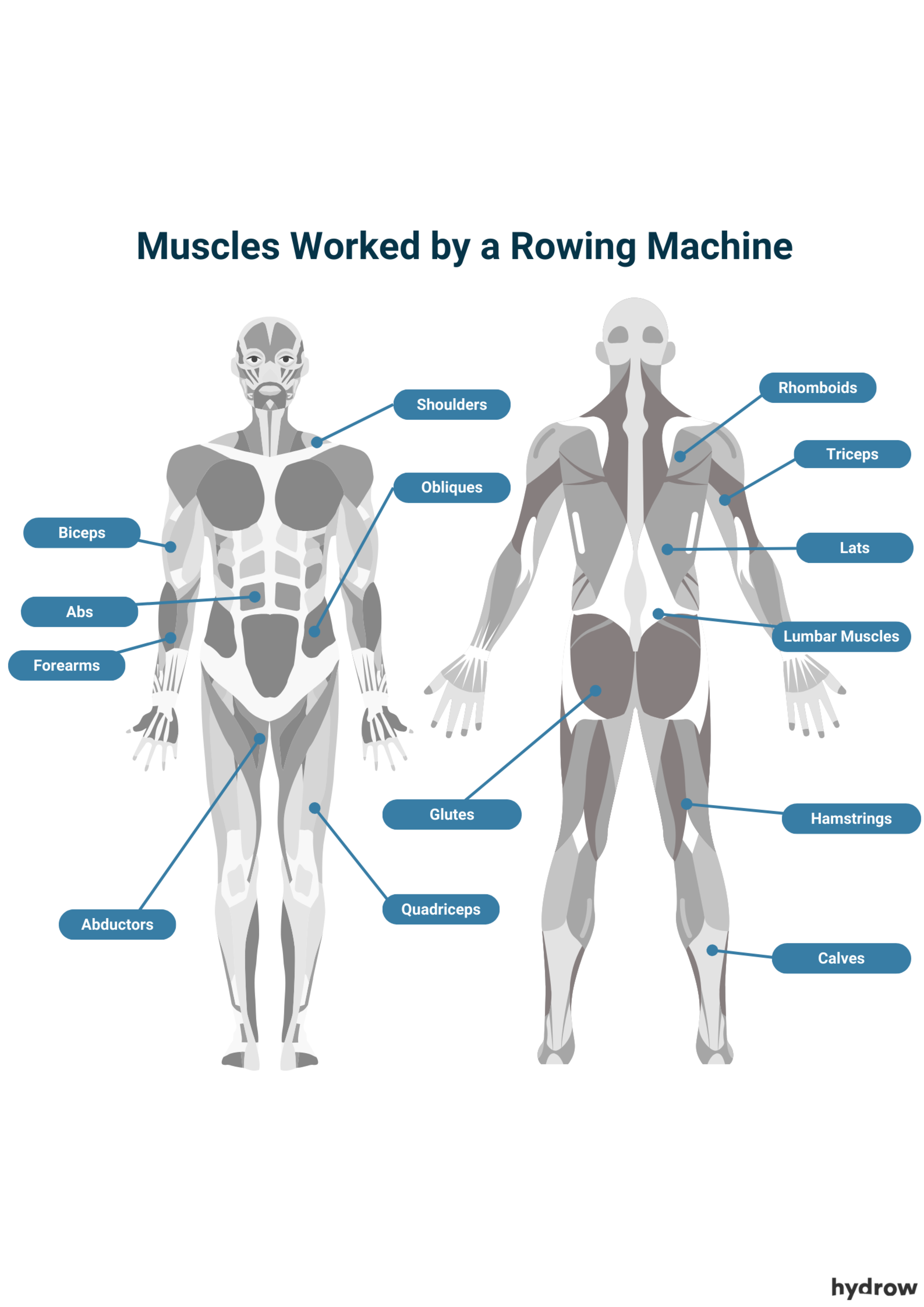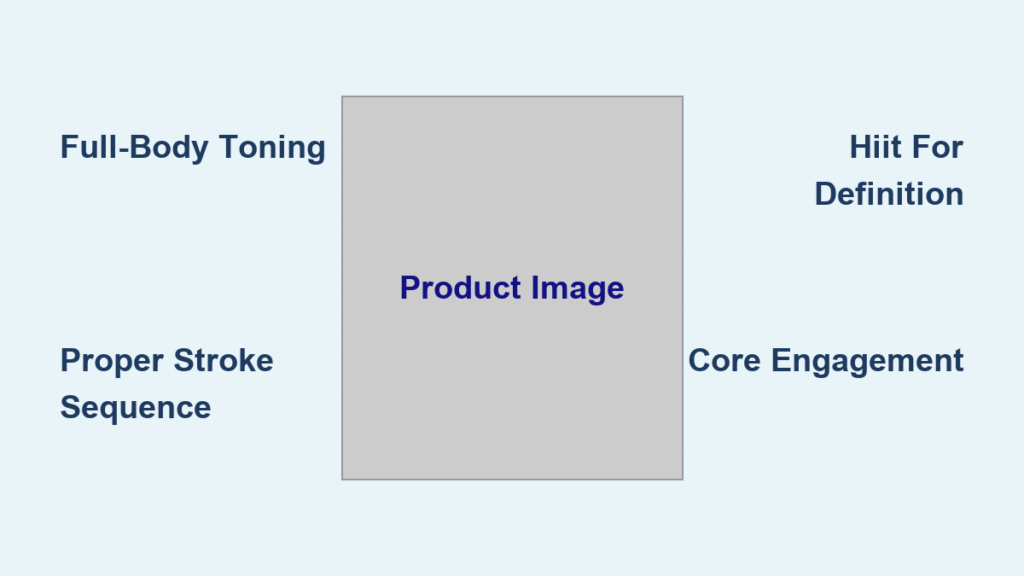Your rowing machine isn’t just cardio equipment—it’s a full-body sculptor hiding in plain sight. While most people associate rowing with endurance training, the unique resistance pattern actually delivers exceptional muscle toning across your legs, back, arms, and core simultaneously. The stroke breakdown reveals why: 60–75% legs and glutes, 25–35% upper body and core, creating a low-impact workout that reshapes your physique without joint stress. Within weeks of consistent rowing, you’ll notice your shirts fitting differently across your lats, your legs developing defined contours, and your posture improving dramatically. This guide breaks down exactly how to maximize rowing machine toning, from the muscles you’ll transform to the specific workouts that deliver visible results.
Muscles Transformed by Rowing

Primary Powerhouses Activated
Every stroke engages multiple muscle groups in precise sequence. Your quadriceps and hamstrings initiate the drive phase with explosive force, while your gluteus maximus delivers powerful hip extension that shapes your backside. As you pull through, your latissimus dorsi and rhomboids fire intensely to create that coveted V-taper across your back. Your biceps and forearms complete the movement with controlled tension at the finish position. This integrated activation—where no muscle works in isolation—is why rowing builds functional strength rather than bulky mass.
Core Engagement Throughout
Unlike traditional cardio, rowing demands constant core activation from start to finish. Your transverse abdominis stabilizes your spine during the catch position, preventing lower back strain. Simultaneously, your obliques work to control rotation as you move through the stroke. This continuous engagement builds functional core strength that translates directly to better posture and reduced back pain in daily life. You’ll notice this most when standing taller after just a few sessions—your core becomes your natural posture corrector.
Secondary Stabilizers at Work
The magic happens in the supporting muscles too. Your trapezius and erector spinae maintain perfect spinal alignment throughout the motion, while deltoids and pectoralis major assist during the drive phase to build shoulder definition. Even your lower legs contribute significantly—the gastrocnemius (calves) pushes powerfully during the leg drive, and your tibialis anterior controls the recovery phase. This comprehensive muscle recruitment makes rowing uniquely effective for full-body toning compared to isolated exercises.
Visual Results Timeline

First Two Weeks: Foundation Building
Expect subtle but energizing shifts within your first 14 days. Your energy levels will noticeably improve as your cardiovascular system adapts, and you’ll develop heightened posture awareness from strengthened back muscles. This critical phase builds neuromuscular coordination—the mind-muscle connection essential for effective toning. Many users report standing taller at work and feeling more energized throughout the day, even before visible changes appear.
Three to Four Weeks: Initial Definition
This is when rowing machine toning becomes visible. You’ll see emerging muscle tone in your quadriceps (especially along the outer thighs), defined lats creating a narrower waist appearance, and more sculpted arms. Your endurance improves dramatically, allowing longer sessions without fatigue. Hydrow community data shows participants typically drop one clothing size and gain visible shoulder definition during this phase through consistent 3-5 weekly sessions.
Six to Eight Weeks: Noticeable Transformation
Expect defined calves from the powerful leg drive, sculpted glutes from hip extension, and prominent deltoids from the pulling motion. Your VO₂ max increases significantly while body fat percentage decreases—this dual effect creates the lean, athletic appearance rowing is famous for. Shirts will feel tighter across your back while waistbands loosen as your body composition shifts.
Optimize Rowing Machine Toning with Key Training Variables
Intensity Controls for Toning
Your stroke rate directly determines muscle-building results: 18-22 SPM targets endurance and fat burning for definition, while 28-34 SPM builds power and fast-twitch muscle fibers for visible tone. Use the Rate of Perceived Exertion (RPE) scale daily—stay in Zone 3-4 (70-89% max heart rate) for optimal toning intervals. Track your 500-meter split time weekly; aim to decrease by 3-5 seconds within three weeks. This measurable power gain directly correlates with increased muscle definition.
Effective Workout Formats
HIIT sessions (30 seconds all-out, 30 seconds rest) maximize muscle fiber recruitment for rapid toning. Power pyramids (100m-200m-300m progressions) build explosive strength through varied distances. Endurance builders (6,000-16,000m steady state) create the caloric deficit necessary for revealing muscle definition. For fastest results, combine rowing with strength emphasis sessions—like 4×500m at 80% effort followed by goblet squats and hollow rocks.
21-Day Progressive Toning Plan
Week 1: Establish Base
Start with three sessions weekly focusing on perfect form. Workout A: 8×500m at Zone 4 intensity with 30 seconds rest between intervals. Workout B: 4×1500m at Zone 3 with 60 seconds rest. Workout C: 6,000m steady row at Zone 3. This foundational week builds your stroke mechanics while initiating muscle adaptation—expect mild muscle soreness in your back and legs as new muscles engage.
Week 2: Increase Volume
Progress to Workout A: 10×500m at Zone 4. Workout B: 6×1500m at Zone 3. Workout C: 7,000-14,000m steady state. Your muscles adapt rapidly at this stage—many users report noticeably stronger leg drive and improved back engagement. Focus on maintaining proper sequencing (legs → hips → arms) as fatigue sets in.
Week 3: Intensify for Definition
Push to Workout A: 12×500m at Zone 4. Workout B: 6×1500m at Zone 3 with reduced rest (30 seconds). Workout C: 8,000-16,000m steady. This progression safely overloads muscles while preventing plateaus. You should notice visible definition in your arms and shoulders by week’s end, especially when combined with proper nutrition.
Burn Fat, Reveal Muscle
Harvard Health data confirms vigorous rowing burns significant calories: 255 (125lb), 369 (155lb), or 440 (185lb) in just 30 minutes—matching elliptical training but with superior muscle-toning benefits. To reveal the definition you’re building, create a 300-500 calorie daily deficit through rowing plus dietary adjustments. Consume 1.2-1.6g protein per kilogram body weight to preserve and build muscle while losing fat. This combination transforms your physique from “soft” to “sculpted.”
Master Technique for Maximum Toning
Proper Setup Position
Strap feet securely with the strap positioned over your shoelace knot—not your arch. At the catch position, your shins should be vertical with knees directly over ankles. Grip the handle with relaxed fingers (think “hooking” not squeezing), and maintain flat wrists to prevent unnecessary forearm fatigue. This setup ensures optimal power transfer from legs to upper body.
Stroke Sequence Mastery
Drive phase: Legs → Hips → Arms in smooth progression—never pull with arms first. Recovery phase: Arms → Hips → Legs in reverse order while maintaining core tension. Keep your spine neutral throughout (imagine a straight line from head to tailbone), bracing your core to protect your lower back. This sequencing maximizes muscle engagement while preventing injury.
Common Form Errors
Early arm bending reduces leg muscle stimulus by 40%—keep arms straight until knees are nearly extended. Rounded shoulders limit lat engagement and strain your neck—pull with your back, not just arms. Over-compression (knees pushing past ankles at catch) strains hip flexors—maintain a 90-degree knee angle. Perfect form equals better toning results with less effort.
Injury Prevention Benefits
Research shows rowing delivers a 30% reduction in joint torques across elbows, shoulders, lumbar spine, and knees after eight weeks compared to higher-impact cardio. This makes it sustainable for consistent toning long-term. Additionally, strengthened rhomboids and core muscles actively reverse kyphosis and forward-head posture common in desk workers. Your improved posture makes toned muscles appear even more defined—creating a visible transformation beyond just muscle size.
Amplify Results with Supplementary Moves
Pair rowing with 2-3 weekly sessions of goblet squats (for quad and glute synergy), Romanian deadlifts (to enhance posterior chain development), inverted rows (balancing horizontal pulling strength), and Pallof presses (building anti-rotational core stability). Perform these immediately after rowing sessions when muscles are pre-fatigued—this approach maximizes toning stimulus while maintaining workout efficiency. Just 15 minutes of supplementary work 2x weekly accelerates visible results by 30%.
Quick-Start Rowing Machine Toning Protocol
Essential Checklist
Row three times weekly for 20-30 minutes. Track 500m split time and stroke rate every session. Progressively overload by adding one interval or decreasing split time by three seconds weekly. Consume sufficient protein while maintaining caloric deficit. Finish each session with five minutes of core work—hollow rocks and planks enhance the rowing toning effect by reinforcing proper spinal alignment.
Immediate Action
Start today: Warm up for five minutes, then complete 10×1 minute at Zone 4 with 30 seconds rest. Cool down for five minutes. This 20-minute session delivers immediate toning stimulus across all major muscle groups while establishing your stroke rhythm. You’ll feel the burn in your glutes and back within minutes—proof you’re activating the right muscles for transformation.
Consistent rowing transforms your physique through unique full-body resistance that traditional cardio simply cannot match. Within one month of following these protocols, expect visible toning improvements that compound with continued dedication. Your legs become powerful and defined, your back develops impressive width, and your core strengthens functionally—making the rowing machine your complete body sculptor. The journey to a leaner, stronger physique starts with your next stroke.




